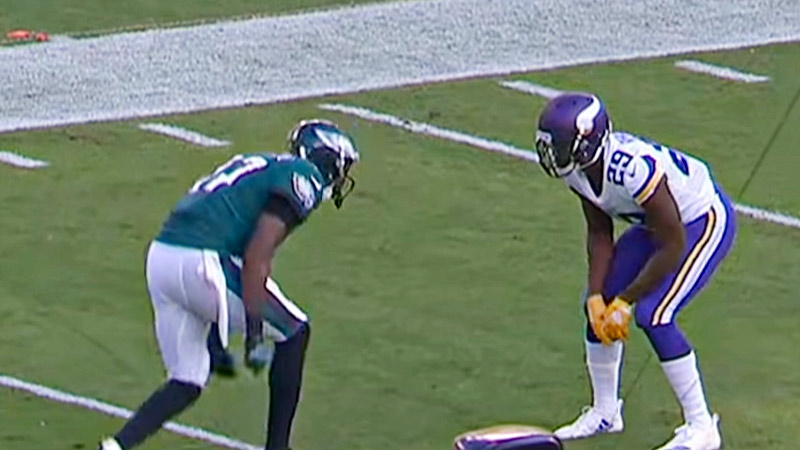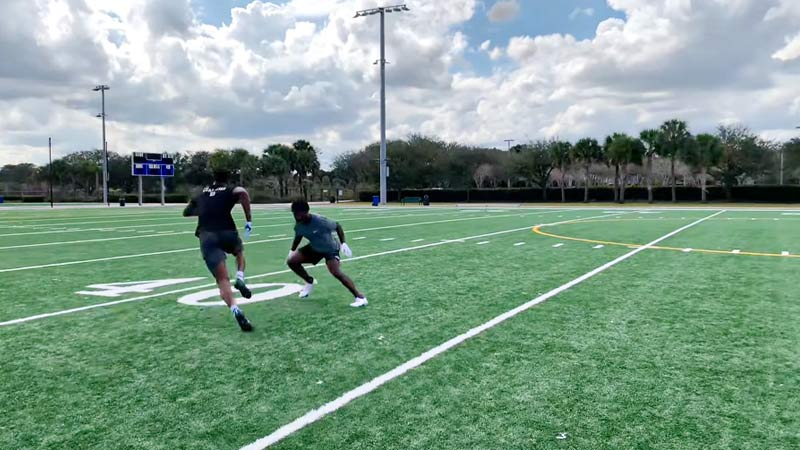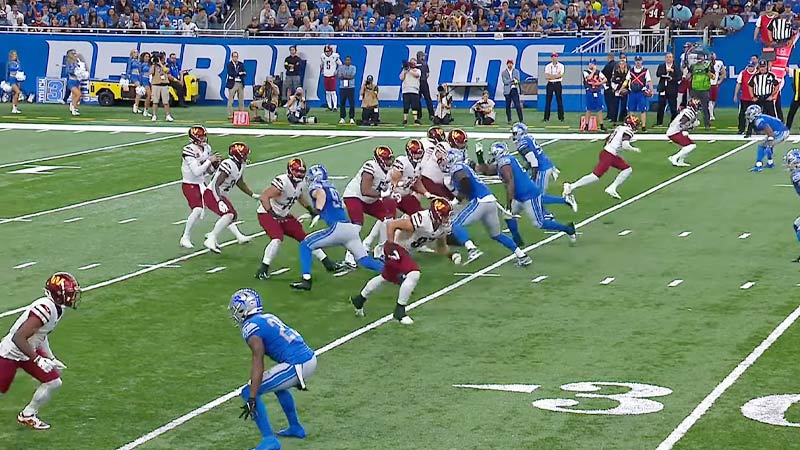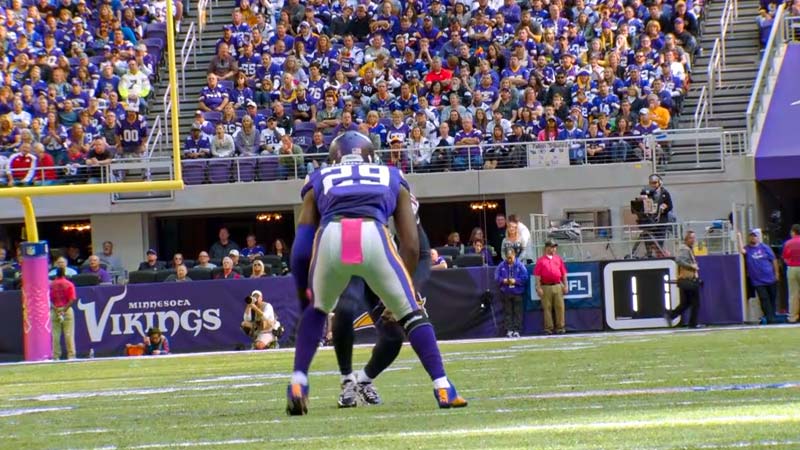When it comes to the intricate dance of American football, few tactics are as compelling and impactful as press coverage. This defensive strategy, characterized by physicality, anticipation, and agility, has the potential to disrupt an opponent’s passing game and shift the tide of a match.
In this comprehensive guide, we delve into the nuances of football press coverage, exploring its mechanics, effects, and strategies.
Whether you’re a seasoned fan or just beginning to unravel the complexities of the game, read on to uncover the answers to five common questions surrounding this captivating defensive technique. So, stay focused.
What Is Football Press Coverage?
Football press coverage is a defensive strategy employed in American football, particularly in passing situations. In this technique, defensive players closely engage the opposing team’s receivers at the line of scrimmage, aiming to disrupt their routes and timing with the quarterback.
The defenders physically “press” the receivers, aiming to jam them and redirect their paths, making it harder for them to get open and receive passes.
Press coverage requires quick reactions, physicality, and precise technique from the defenders. It aims to disrupt the rhythm of the opposing offense and give the pass rush more time to pressure the quarterback.
However, if not executed effectively, it can leave defenders vulnerable to big plays if the receivers manage to break free. Successful press coverage hinges on the balance between aggression and maintaining coverage integrity downfield.
When to Use Press Coverage in Football?

Press coverage is typically employed in specific situations during a football game to disrupt the opposing team’s passing game and gain a defensive advantage. It is most effective when:
Passing Downs
Press coverage is commonly used on passing downs when the defense expects the offense to attempt a pass play. This is because press coverage can disrupt the timing between the quarterback and receivers, potentially leading to incomplete passes or interceptions.
Talented Defensive Backs
If a team has skilled cornerbacks or defensive backs who excel in man-to-man coverage and have the physicality to jam receivers at the line of scrimmage, press coverage can be a valuable strategy.
Short Yardage Situations
In situations where the offense needs only a few yards to gain a first down, press coverage can help prevent quick and easy completions, forcing the offense into longer down-and-distance situations.
Red Zone
Inside the red zone (the area near the opponent’s goal line), press coverage can be used to limit the space available for receivers to maneuver and make it challenging for the offense to execute precise passing plays.
Predictable Passing Plays
When the defense anticipates a pass play based on the offensive formation or tendencies, using press coverage can disrupt the intended routes and make it harder for receivers to get open.
Limited Deep Threats
If the opposing offense lacks speedy deep-threat receivers, press coverage can be more effective as defenders are less likely to be beaten deep down the field.
Complementary Pass Rush
Press coverage can work well when paired with an effective pass rush, as it gives the defensive line more time to pressure the quarterback while the receivers are being impeded at the line of scrimmage.
It’s important for coaches and defensive coordinators to assess the strengths and weaknesses of their own defensive backs and the opposing offense’s receiving corps to determine when press coverage is the most suitable strategy.
Mirror Technique in Football Press Coverage

The mirror technique is a fundamental aspect of football press coverage used by defensive backs to effectively shadow and cover wide receivers.
In press coverage, the mirror technique involves mirroring the movements of the receiver while maintaining proper positioning and leverage. Here’s how it works:
Stance and Alignment
The defensive back lines up in a position that allows them to engage the receiver at the line of scrimmage. This typically involves a balanced stance, with knees slightly bent and weight on the balls of the feet.
Initial Jam
As the ball is snapped, the defensive back uses their hands and body to deliver a controlled jam to the receiver, aiming to disrupt their release off the line of scrimmage and alter their route. The objective is to redirect the receiver’s path and throw off the timing between the quarterback and receiver.
Mirroring
After the initial jam, the defensive back transitions into mirroring the receiver’s movements. The goal is to stay in close proximity to the receiver, reacting to their cuts, breaks, and changes in direction.
The defender must move in sync with the receiver, staying a step or two behind while anticipating their route.
Leverage
The defensive back maintains leverage, positioning themselves between the receiver and the quarterback, which makes it harder for the receiver to create separation.
This involves angling their body to force the receiver toward the sideline or an area where they have help from the rest of the defense.
Use of Hands
While mirroring, the defender uses their hands to gauge the receiver’s actions and maintain contact within the allowable limits. The hands are used for balance, control, and steering the receiver’s movements.
Reacting to Breaks
When the receiver makes a cut or a break in their route, the defensive back reacts by matching the move and maintaining the same distance. This is crucial to prevent the receiver from gaining separation and being open for a pass.
Turning to Locate the Ball
If the ball is in the air, the defensive back must turn their head and locate the ball while still maintaining contact with the receiver. This allows them to make a play on the ball and potentially create an interception or pass breakup.
The mirror technique requires a combination of quick footwork, agility, anticipation, and physicality. It’s essential for defensive backs to strike a balance between staying close to the receiver and avoiding penalties for holding or illegal contact.
Jam Technique in Press Coverage

The jam technique is a key component of press coverage in football, where a defensive back (usually a cornerback) attempts to disrupt a wide receiver’s release off the line of scrimmage by using physicality and leverage. Here’s an overview of the Jam Technique:
Stance and Alignment
The defensive back lines up in close proximity to the receiver at the line of scrimmage. The stance is usually lower and more aggressive than in off-coverage situations, with the defender’s weight on the balls of their feet for quick reaction.
Initial Contact
As the ball is snapped, the defensive back makes immediate contact with the receiver using their hands and arms. The objective is to disrupt the receiver’s timing, release, and route by altering their path and slowing them down.
Technique Variations
There are two primary types of jam techniques: “Press-Bail” and “Press-Turn.”
Press-Bail
In this variation, after making initial contact, the defender immediately retreats while maintaining contact with the receiver. This is done to prevent the receiver from gaining a quick release and to give the defender an opportunity to read the play and react accordingly.
Press-Turn
In this variation, the defender continues to engage the receiver and attempt to steer them off their intended route. The goal is to physically control the receiver’s movement and force them into a less advantageous position on the field.
Hand Placement
The defensive back uses their hands to control the receiver’s chest, shoulders, or arms, aiming to disrupt their balance and timing. Proper hand placement is essential to avoid penalties for illegal contact.
Leverage
The defender uses their body to position themselves between the receiver and the quarterback. They might angle their body to force the receiver toward the sideline or an area with help from other defenders.
Reacting to Receiver’s Moves
The defensive back must be prepared to react to the receiver’s attempts to break free from the jam. This involves quick footwork, balance, and maintaining contact while adjusting to the receiver’s route.
Transition
Depending on the situation, the defender may transition from the jam into the mirror technique, where they continue to closely shadow the receiver’s movements downfield.
The jam technique requires a combination of physical strength, timing, hand-eye coordination, and understanding of the receiver’s tendencies.
It’s important for defensive backs to be mindful of the five-yard “illegal contact” rule in the NFL, which limits the amount of physical contact allowed beyond that distance from the line of scrimmage.
Impact of Football Press Coverage

Football press coverage has a significant impact on both the defensive and offensive aspects of the game:
Defensive Impact
- Disruption of Timing: Press coverage disrupts the timing between the quarterback and receivers by physically impeding their releases off the line of scrimmage. This can lead to rushed throws, incomplete passes, and interceptions.
- Reduced Route Options: Press coverage limits the variety of routes that receivers can effectively run, as they must contend with the physical contact and redirection imposed by the defender. This narrows down the options available to the offense and makes it easier for the defense to anticipate routes.
- Pressure on Quarterback: The extra time created by press coverage can allow the defensive pass rush more opportunities to pressure the quarterback. This can force quicker decisions and lead to mistakes under pressure.
- Red Zone Effectiveness: Press coverage can be particularly effective in the red zone, where the condensed field limits the space for receivers to maneuver. Defenders can use physicality to deny quick and easy scoring opportunities.
Offensive Impact
- Challenging for Receivers: Press coverage makes it difficult for receivers to gain separation, which is crucial for successful pass plays. Receivers need to possess exceptional releases, agility, and route-running skills to counter press coverage effectively.
- Adjustments Required: Offenses facing press coverage need to adjust their game plan. This might involve using quick-hitting routes, rub concepts, or creating mismatches to counter the physicality of the defenders.
- Explosive Play Potential: If receivers manage to beat the press coverage, they have the potential to create big plays due to the increased likelihood of having more space to work with down the field.
- Opening Run Opportunities: As defenders commit to press coverage, they may be more focused on pass defense. This can create opportunities for the offense to exploit the run game, especially if the defense is sacrificing support from safeties and linebackers.
- Penalty Potential: Aggressive press coverage can lead to penalties if defenders go beyond the allowable contact window or engage in holding. These penalties can give the offense free yards and first downs.
How to Defend Football Press Coverage
Defending against football press coverage requires a well-executed offensive strategy and individual skills by the receivers, quarterback, and offensive line. Here’s how to effectively counter press coverage:
Release Techniques
- Receivers should work on their release techniques to get off the line of scrimmage quickly and cleanly. This involves using hand techniques, footwork, and body positioning to counter the physicality of the defender.
- Quick, precise footwork can help receivers avoid getting jammed at the line, making it harder for defenders to disrupt their routes.
Route Variability
- Incorporate a mix of route concepts that create separation against press coverage. Routes like slants, quick outs, and crossing patterns can be effective as they force defenders to react quickly.
- Use combination routes that involve rubs and picks to create confusion among defenders and help receivers break free.
Quick Passing Game
Employ a quick passing game that enables the quarterback to release the ball rapidly. Short, timed throws can exploit the space left by defenders playing up close and limit the time for the pass rush to pressure the quarterback.
Pre-Snap Reads
Quarterbacks should read the alignment and positioning of defenders before the snap. Identifying where the pressure is coming from and locating potential mismatches can help them make quicker decisions.
Hot Reads and Audibles
Designate hot routes for receivers in case they encounter press coverage. These routes are designed to be quick and easy options for the quarterback when facing immediate pressure.
Offensive Line Protection
A strong offensive line performance is essential. Providing the quarterback with a clean pocket and enough time to make throws can alleviate the impact of press coverage.
Stacking and Releases
- Receivers can use techniques like stacking, where one receiver aligns behind another, to create separation and disrupt the defender’s ability to jam effectively.
- Employ double releases, where receivers initially move in one direction before quickly changing course, to deceive defenders and gain separation.
Motion and Shifts
Utilize pre-snap motion and shifts to force defenders to adjust their positioning. This can help receivers get a clean release and create confusion in the defense.
Physicality and Aggressiveness
Encourage receivers to use their own physicality to counter the defender’s aggression. Hand-fighting and maintaining balance can help them break free from contact.
Capitalizing on Mistakes
If defenders overcommit or make mistakes during press coverage, receivers should take advantage of any openings by exploiting the space created.
FAQs
What is Football Press Coverage?
Football press coverage is a defensive strategy employed in passing situations, where defensive players closely engage the opposing team’s receivers at the line of scrimmage. The goal is to disrupt their routes, timing, and ability to get open, ultimately making it harder for the quarterback to complete passes.
When and Why is Press Coverage Used?
Press coverage is utilized in specific game situations such as passing downs, red zone scenarios, and when defenders are confident in their man-to-man coverage abilities. It disrupts the opponent’s timing, reduces the range of route options, and gives the pass rush more time to pressure the quarterback.
What Techniques Are Involved in Press Coverage?
There are two core techniques within press coverage: the “jam” technique and the “mirror” technique.
The jam involves physically disrupting the receiver’s release at the line of scrimmage, while the mirror technique requires closely shadowing the receiver’s movements while maintaining proper positioning and leverage.
How Can Offenses Counter Press Coverage?
Offenses can counter press coverage through quick releases, diverse route concepts, pre-snap reads, and adjustments in alignment.
The use of stacked formations, motion, and shifts can help receivers gain separation and confuse defenders, while a strong offensive line protects the quarterback and allows for quick passes.
What’s the Impact of Press Coverage on the Game?
Press coverage has a profound impact on both defensive and offensive strategies. It disrupts timing, limits route options, and increases the potential for turnovers on defense.
On offense, receivers must rely on technique, agility, and adjustments to counter the physicality, and quick passing becomes pivotal to exploit the gaps in the defense.
Wrapping Up
Football press coverage is a strategic art form that brings a unique blend of physicality and finesse to the field.
As defenders lock horns with receivers at the line of scrimmage, the game’s dynamics shift, presenting challenges and opportunities on both sides of the ball.
By understanding the ins and outs of press coverage, fans and players alike can gain a deeper appreciation for the tactics that shape the outcome of every pass, catch, and interception. Thank you for your support.







